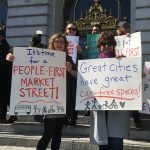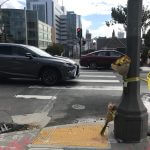Join us on October 20 in demanding the City refocus on Vision Zero NOW
In 2014, our city committed to end severe and fatal traffic injuries within ten years. As only the second city in the United States to adopt Vision Zero, San Francisco embraced an interagency, data-driven, multi-layered approach to prevent the tragedies occurring regularly on our streets.
In the years since, we’ve seen important shifts in how the city approaches traffic safety because of Vision Zero. We now know that 75% of crashes occur on just 13% of our streets: the high-injury network. And the high-injury network is now the priority for safety improvements. We’ve seen deadly streets like Folsom, Cesar Chavez, Polk, and Valencia get big changes.
SFMTA’s Vision Zero Quick Build policy passed last year seriously cut the red tape for getting short-term safety improvements added to a street or intersection. Private vehicles are no longer allowed on Market Street, where 500,000 people walk every day and half of the city’s most dangerous intersections are.
And yet, we haven’t seen any real shift in the numbers that matter most. Around 30 people continue to be killed and nearly 600 severely injured each year on San Francisco streets.
The threat is rising: we know in the past five years that traffic has dramatically increased, as has dangerous driving behavior. But we also know our city can be doing more when it comes to Vision Zero, especially when it comes to applying simple, affordable safety solutions across the high-injury network.
Vision Zero continues to be our best hope for making our streets safe for everyone, of every age and ability. But for Vision Zero to reach its potential, our city leaders must prioritize and invest in it with the utmost urgency… and think much bigger and more strategically.
So I’m asking you to speak at the Tuesday, October 20 SFMTA Board meeting to send this message loud and clear. This is a key meeting for people like you to be at (virtually, that is) as SFMTA staff will present on the progress made and lessons learned since the adoption of Vision Zero. This is a chance to get more accountability, transparency, and tough questions answered.
Cities around the world are showing what a laser focus on Vision Zero looks like. Oslo, Norway had zero pedestrian and bicyclist deaths in 2019, as did Helsinki, Finland. Mexico City is proving that Vision Zero is viable in non-European cities. Here in the United States, New York’s comprehensive approach has started to notably move the needle, and smaller cities like Minneapolis-St. Paul, Boston, Portland, and Seattle have made bold moves to reduce speeds.
We need San Francisco to act similarly. We need SFMTA to put solutions in place this year to keep people safe when simply crossing the street. And we need SFMTA to have an outcomes-focused, detailed plan for Vision Zero moving forward.
I continue to believe that San Francisco could be the place that sets the bar for safe streets, but it will take all of us in order to build the political will for bold action. I hope to hear your voice on Tuesday!
Stand for safe streets and support this work. Become a member now.
The photo is from the intersection where a pedestrians was the victim of a fatal hit-and-run at Cesar Chavez Street and Evans Avenue the morning of Friday, October 2, 2020.




